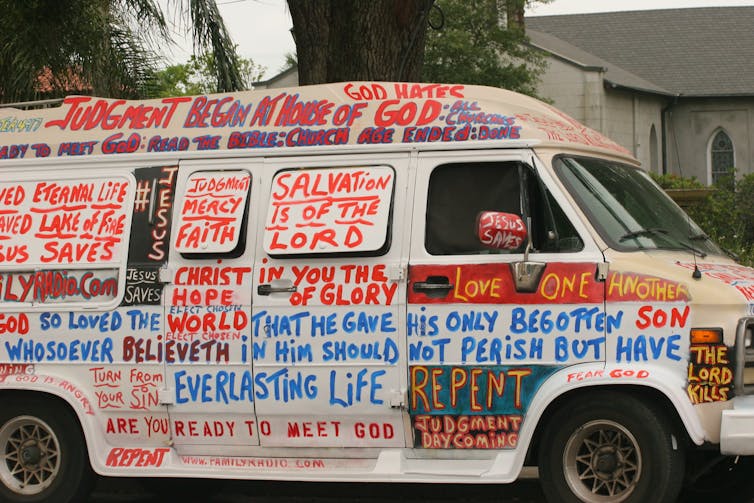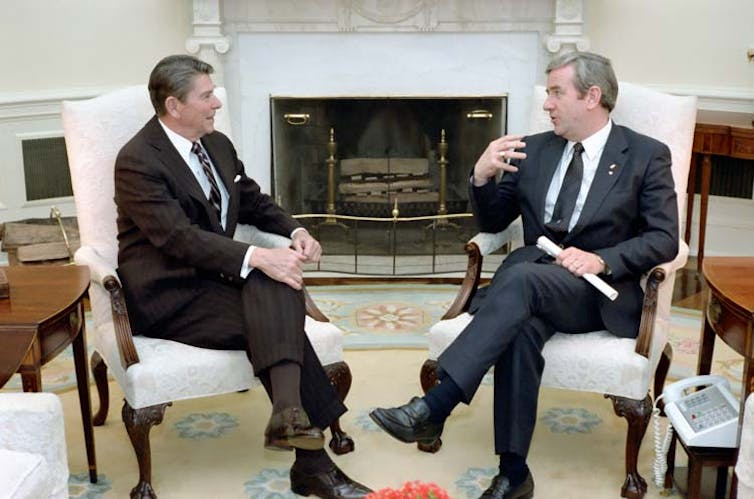Fundamentalism turns 100, a landmark for the Christian Right
- Written by William Trollinger, Professor of History, University of Dayton
These days, the term “fundamentalism” is often associated with a militant form of Islam[1].
But the original fundamentalist movement was actually Christian[2]. And it was born in the United States a century ago this year.
Protestant fundamentalism is still very much alive. And, as Susan Trollinger and I[3] discuss in our 2016 book[4], it has fueled today’s culture war over gender, sexual orientation, science and American religious identity.
Roots of Fundamentalism
Christian fundamentalism has roots in the 19th century, when Protestants were confronted by two challenges to traditional understandings of the Bible.
Throughout the century, scholars increasingly evaluated the Bible as a historical text[5]. In the process they raised questions about its divine origins, given its seeming inconsistencies and errors.
In addition, Charles Darwin’s 1859 book “On the Origin of Species[6]” – which laid out the theory of evolution by natural selection – raised profound questions about the Genesis account of creation.
Many American Protestants easily squared their Christian faith with these ideas. Others were horrified.
Conservative theologians responded by developing the doctrine of biblical inerrancy[7]. Inerrancy asserts that the Bible is errorless and factually accurate in everything it says – including about science.
This doctrine became the theological touchstone of fundamentalism. Alongside inerrancy emerged a system of ideas, called apocalyptic or “dispensational premillennialism[8].”
Adherents of these ideas hold that reading the Bible literally – particularly the Book of Revelation – reveals that history will end soon with a ghastly apocalypse.
All those who are not true Christians will be slaughtered. In the wake of this violence, Christ will establish God’s millennial kingdom on Earth.
 Christian fundamentalists have remained consistent in their core beliefs for a century.
Shutterstock[9]
Christian fundamentalists have remained consistent in their core beliefs for a century.
Shutterstock[9]
Setting the stage
A series of Bible and prophecy conferences[10] spread these ideas to thousands of Protestants across the United States in the late 19th century.
But two early 20th-century publications were particularly key to their dissemination.
The first was author Cyrus Scofield’s 1909 Reference Bible[11]. Scofield’s Bible included an overwhelming set of footnotes emphasizing that the errorless Bible predicts a violent end of history which only true Christians will survive.
The second was “The Fundamentals[12],” 12 volumes published between 1910 and 1915 which made the case[13] for biblical inerrancy while simultaneously attacking socialism and affirming capitalism.
“The Fundamentals” provided the name of the future religious movement. But there was not yet a fundamentalist movement.
That came after World War I.
The birth of the Fundamentalist Movement
After Woodrow Wilson’s April 1917 declaration of war on Germany, the government mobilized a huge propaganda campaign[14] designed to demonize the Germans as barbarous Huns who threatened Western civilization. Many conservative Protestants traced Germany’s devolution into depravity to its embrace of Darwinism and de-emphasis of the Bible’s divine origins[15].
Six months after the war’s end, William Bell Riley – pastor of Minneapolis’ First Baptist Church[16] and a well-known speaker on the Bible’s prophecies regarding the end of history – organized and presided over the World’s Conference on Christian Fundamentals in Philadelphia[17].
This five-day May 1919 meeting attracted over 6,000 people and an all-star lineup of conservative Protestant speakers. It produced the World’s Christian Fundamentals Association[18], which birthed a movement that influences American political and social life today.
In summer and fall of 1919[19] Riley sent teams of speakers to spread the fundamentalist word across the U.S. In addition to promoting biblical inerrancy and apocalyptic premillennialism, they attacked socialism and Darwinism.
Soon, Riley and his newly minted fundamentalists began trying to capture control of major Protestant denominations[20] and eliminate the teaching of Darwinian evolution[21] from American public schools.
The anti-evolution crusade had some success in the South. Five states[22] passed laws banning the theory of evolution from classrooms.
In March 1925 Tennessee made it illegal[23] to teach “that man has descended from a lower order of animals.” Four months later a science teacher named John Scopes was tried and convicted of violating the statute.
 A historic marker outside the Dayton, Tenn., courthouse where the 1925 Scopes Trial was held.
AP Photo/Mark Humphrey[24]
A historic marker outside the Dayton, Tenn., courthouse where the 1925 Scopes Trial was held.
AP Photo/Mark Humphrey[24]
Fundamentalism after Scopes
Though the Scopes Trial[25] brought ridicule by the national media, fundamentalism did not wither away.
Instead, it continued to advance[26] during the 20th century. And it remained remarkably consistent in its central commitments[27] of biblical inerrancy, apocalyptic premillennialism, creationism and patriarchy – the idea that women are to submit to male authority in church and home.
Fundamentalists also embraced political conservatism. This commitment grew more intense as the 20th century progressed.
Fundamentalists[28] despised President Franklin Roosevelt’s New Deal[29]. They saw welfare to the poor and increased taxes on the rich as an indefensible expansion of government powers.
When the Cold War brought the United States into conflict with the Soviet Union, their concerns about the all-encompassing, anti-Christian state intensified[30].
Then came the 1960s and 1970s.
Fundamentalists bitterly opposed[31] the civil rights and feminist movements, the Supreme Court’s rulings prohibiting school-sponsored prayer[32] and affirming a woman’s right to an abortion[33], and President Lyndon Johnson’s programs that sought to eliminate poverty and racial injustice[34].
Fundamentalists go political
Understanding Christian America to be under deadly assault, in the late 1970s these politically conservative fundamentalists began to organize.
The emergent Christian Right attached itself to the Republican Party, which was more aligned with its members’ central commitments than the Democrats.
In the vanguard was Baptist preacher Jerry Falwell Sr. His “Moral Majority[35]” sought to make America Christian again[36] by electing “pro-family, pro-life, pro-Bible morality” candidates.
 President Ronald Reagan with pastor Jerry Falwell Sr., in March 1983.
White House/ Ronald Reagan Presidential Library[37]
President Ronald Reagan with pastor Jerry Falwell Sr., in March 1983.
White House/ Ronald Reagan Presidential Library[37]
Since the 1980s, the movement has become increasingly sophisticated. Christian Right organizations like Focus on the Family and Concerned Women of America[38] push for laws that reflect the fundamentalist views on everything from abortion to sexual orientation.By the time Falwell died, in 2007, the Christian Right had become the most important constituency in the Republican Party[39]. It played a crucial role in electing Donald Trump in 2016[40].
After one century, Protestant fundamentalism is still very much alive in America. William Bell Riley, I wager, would be pleased.

References
- ^ associated with a militant form of Islam (ecommons.udayton.edu)
- ^ Christian (ecommons.udayton.edu)
- ^ Susan Trollinger and I (www.cambridge.org)
- ^ 2016 book (jhupbooks.press.jhu.edu)
- ^ historical text (books.google.com)
- ^ On the Origin of Species (ecommons.udayton.edu)
- ^ biblical inerrancy (ecommons.udayton.edu)
- ^ apocalyptic or “dispensational premillennialism (books.google.com)
- ^ Shutterstock (www.shutterstock.com)
- ^ Bible and prophecy conferences (books.google.com)
- ^ Cyrus Scofield’s 1909 Reference Bible (books.google.com)
- ^ The Fundamentals (books.google.com)
- ^ made the case (www.uncpress.org)
- ^ mobilized a huge propaganda campaign (blog.oup.com)
- ^ embrace of Darwinism and de-emphasis of the Bible’s divine origins (ecommons.udayton.edu)
- ^ pastor of Minneapolis’ First Baptist Church (books.google.com)
- ^ World’s Conference on Christian Fundamentals in Philadelphia (books.google.com)
- ^ the World’s Christian Fundamentals Association (books.google.com)
- ^ summer and fall of 1919 (www.uncpress.org)
- ^ capture control of major Protestant denominations (ecommons.udayton.edu)
- ^ eliminate the teaching of Darwinian evolution (ecommons.udayton.edu)
- ^ Five states (www.antievolution.org)
- ^ made it illegal (web.archive.org)
- ^ AP Photo/Mark Humphrey (www.apimages.com)
- ^ Scopes Trial (books.google.com)
- ^ continued to advance (ecommons.udayton.edu)
- ^ central commitments (books.google.com)
- ^ Fundamentalists (rightingamerica.net)
- ^ President Franklin Roosevelt’s New Deal (books.google.com)
- ^ intensified (books.google.com)
- ^ opposed (books.google.com)
- ^ prohibiting school-sponsored prayer (www.uscourts.gov)
- ^ affirming a woman’s right to an abortion (www.history.com)
- ^ eliminate poverty and racial injustice (www.penguinrandomhouse.com)
- ^ Moral Majority (books.google.com)
- ^ make America Christian again (theconversation.com)
- ^ White House/ Ronald Reagan Presidential Library (upload.wikimedia.org)
- ^ Focus on the Family and Concerned Women of America (books.google.com)
- ^ most important constituency in the Republican Party (books.google.com)
- ^ electing Donald Trump in 2016 (www.nytimes.com)
Authors: William Trollinger, Professor of History, University of Dayton
Read more http://theconversation.com/fundamentalism-turns-100-a-landmark-for-the-christian-right-123651


